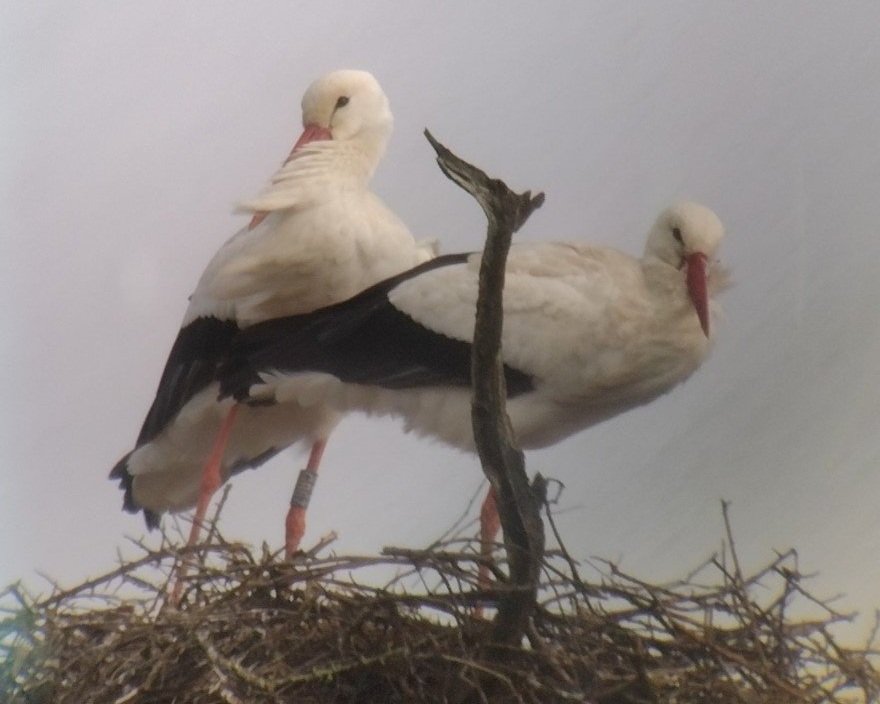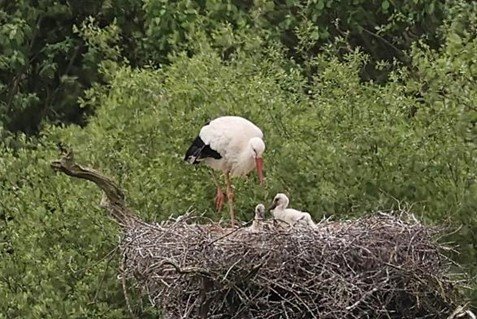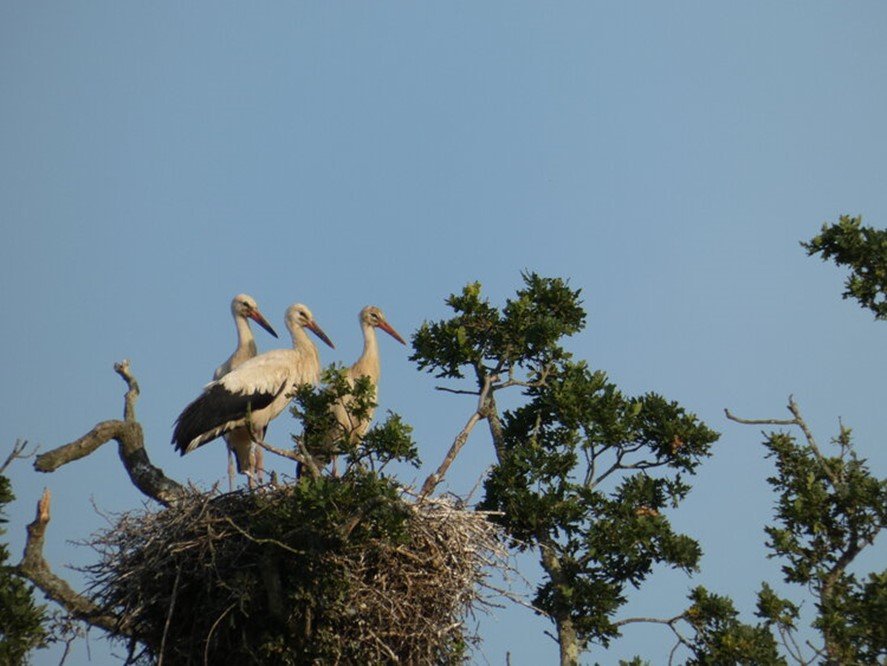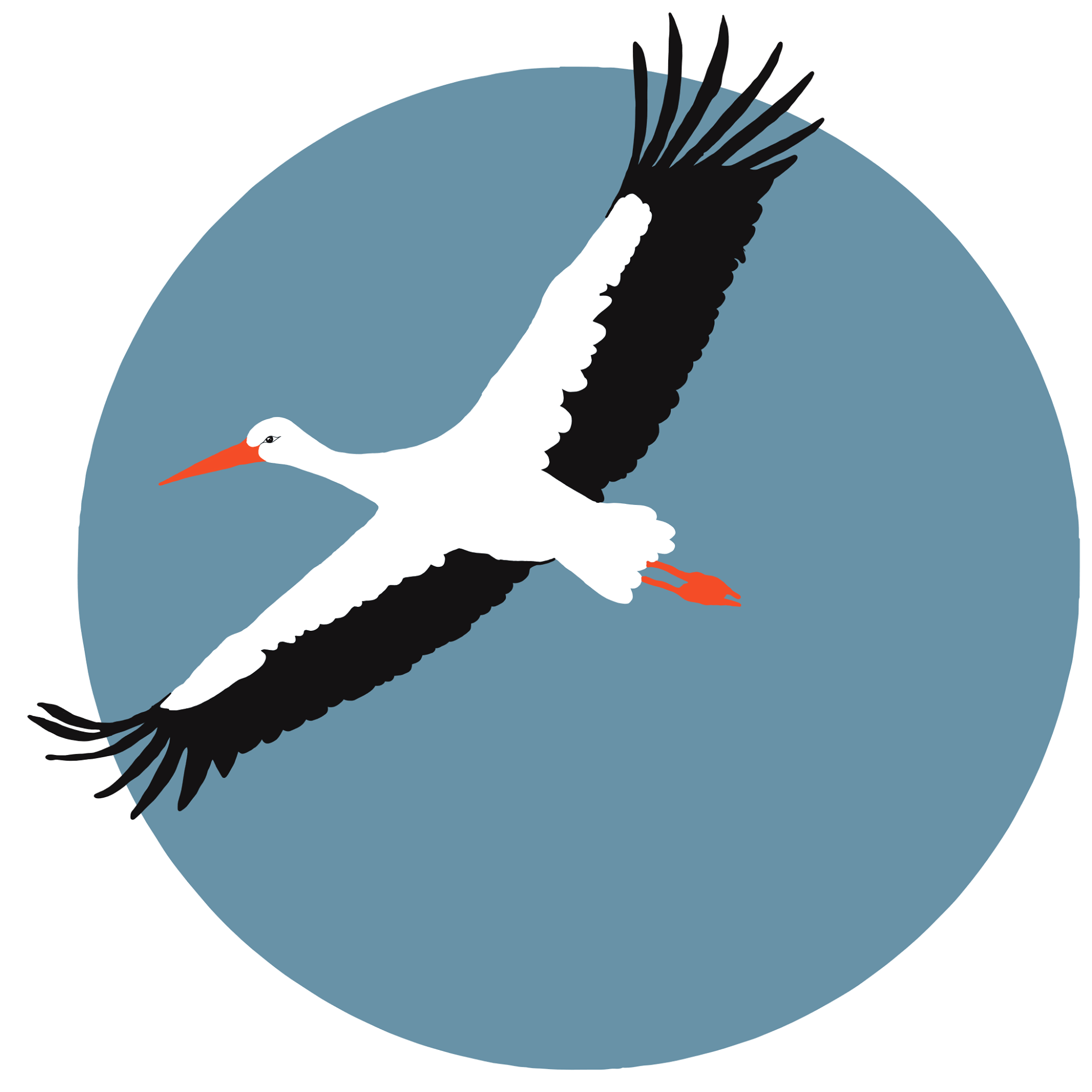News
A Year in the Storks’ RealmOne of our dedicated team of volunteers, Cathy Robinson, has written this wonderful post about her experience of volunteering with the White Stork Project:
Prehistoric wings beat slowly, deliberately. The bird circles the tree, once, twice, three times before finally landing in slow motion. First, long legs drop onto the bowl-shaped pile of sticks, soon followed by a flurry of white and black feathers, a swan-like white neck and a carrot coloured beak. The haphazard nest, as if thrown together as an afterthought, judders but holds fast as the bird slowly folds its wings away.
These birds are the reason I’m sitting on a makeshift camping stool in the middle of a scrubby former field, surrounded by brambles, notebook in hand, my forehead damp from the mizzly rain. As a volunteer stork watcher for the UK White Stork Project, I’ve been watching these birds for over a year now and I’ve been with them through sunshine, gales, rain and hail.

The female bird crouched in the nest throws back her head in greeting and two bills clack clack clack in unison. The sound stirs something deep inside me. The male bird balances on the nest like a tightrope walker as the female hauls herself to her feet, stares at her eggs for a long moment, and launches herself into the air. Her legs trail behind as she flaps, flaps, flaps slowly away, black wingtip feathers reaching out like fingers. At the nest, her mate fussily rearranges their home, picking out scraps of nesting material in the tip of his beak and flinging it aside.
The UK White Stork Project’s ambitious goal is to establish 50 breeding pairs of this lost species in the south of England by 2030. The vast rewilded estate at Knepp was chosen as an ideal location. Not only does it have an astonishingly diverse habitat, supporting a wealth of bird species and a rich banquet of invertebrates – food for the storks – but its location in the south of England means it’s an obvious first stop for any stork flying to the UK from Europe. As a bonus, Knepp’s wildness means storks can do their thing in peace.
Humans and storks rubbed shoulders in Britain for thousands of years, archaeological evidence suggesting they nested here – often choosing nesting sites close to people – as long as 360,000 years ago. Sussex seems to have had a particular connection with these birds, revealed by place names such as Storrington, meaning Village of the Storks. Their rattling greeting would have been part of the background of life for our ancestors. Now long gone, but still buried deep in our consciousness is that sound. Hear it and I guarantee the hairs on the back of your neck will stand to attention.
No one knows exactly why storks disappeared from these shores. They were a delicious addition to the cooking pot in England of old, a tasty treat for the social elite, but their fate may have been sealed by their long links with hope and rebirth, thought to have arisen from Greek mythology. During the English Civil War, this association connected storks with rebellion, and they were persecuted to extinction. Storks hung on in Europe, though, and are a familiar sight, their nests perched atop tall buildings like chimneys or church steeples. They’re welcome there, too, thought to bring good luck. It’s not uncommon to see cartwheels erected onto the roofs of buildings, providing a platform to encourage storks to build their shaggy nests.
Initially, the White Stork Project brought wild-fledged disabled storks from Poland to the Knepp estate. These birds, unable to fly after colliding with power cables or falling victim to road traffic accidents, pottered about in a spacious, open-topped pen in the heart of the estate. The idea of forming this initial static population was to act as an avian magnet, drawing in any wandering storks from Europe which happened to be flying over the UK. The White Stork Project’s two satellite sites, in Wadhurst, East Sussex and Wintershall in Surrey make a convenient flyover triangle in South East England, close to the English Channel. This approach has been successfully used to restore stork populations in other parts of Europe. The strategy worked, as at least two wild birds are thought to be now nesting at Knepp.
The initial population was soon joined by the late summer release of captive-bred birds from the Cotswold Wildlife Park. These wasted no time in taking to the Sussex skies, echoing the past as they rode the thermals like modern pterodactyls.
The UK was in the grip of lockdown in spring 2020 when the first storks to successfully nest in the UK for over 600 years were confirmed to have hatched four precious chicks. Stork watchers and impatient birders were confined to their homes and gardens. But history had been made.
In 2021 the storks were back with a vengeance, this time with seven nests built and 14 chicks fledged. 2022 was a bumper year, with twelve nests, 47 eggs laid and 20 fledging successfully.
Lofty stork nests aren’t the most accessible structures to keep an eye on, and data on stork behaviour in the UK is in its infancy. The observations of stork watchers as we crouch in the undergrowth are helping to build up a picture of the lifestyle of this often surprising bird. Every bill-clacking greeting, every hunched over, wings-extended pair-bonding display, every feeding foray are meticulously recorded, information that will over time provide detailed knowledge about UK storks.
Stork watchers need to play detective, then. It doesn’t take much to deduce when love is in the air – I’ve watched as pairs get together and mate in early spring, serenaded by stereophonic birdsong. Day by day nests grow as the birds fly back and forth, back and forth adding to the construction, stick by painstaking stick. But only by watching and waiting does it become obvious when the birds hunker down, the first clue that eggs have been laid.
I’ve held my breath along with my fellow stork watchers, anxiously checking the calendar and crossing fingers for no fierce spring storms until the first sighting of parent birds regurgitating food into the nest. This means the young storks have successfully chipped their way out of the eggs. Storks lay between four and five eggs, and the tiny chicks aren’t visible from ground level for a couple of weeks. The rush of adrenaline when the first chick pokes its wobbly head over the rim of the nest makes the hours on the camping chair all worthwhile.

An adult White Stork tends to its chicks on the nest. Photo: Rob Dumbrell
Storks are tender parents, placing food into the centre of the nest so all chicks have an equal chance of eating. As the chicks grow older, more boisterous, and ever larger, they jostle each other for space as they rapidly outgrow their home. They soon become their parents’ mini-me’s: hardly distinguishable from the adult birds, save for their grey beaks. There are inevitable casualties along the way. We cheer for the ones that do make it, but such is the bond between watcher and stork, it’s hard to be unaffected by the ones that don’t. Eventually, the lucky ones are spotted trying out their stilt legs for size before, around two months after they hatch, taking their first dizzying flight.
Things don’t always go according to plan in the stork world, however. One of the advantages of having many pairs of eyes trained on a single species – over 40 volunteer stork-watchers are actively involved in the White Stork Project – is the opportunity to bust some myths. And the Knepp storks wasted no time in deciding they didn’t want to be pigeonholed.
Storks are generally believed to return to the same nest site with the same partner year on year. It makes perfect sense for migratory birds like storks to be monogamous because they simply don’t have the time or the energy to look for a new partner after completing a long migration flight. Faithfulness to nesting sites means energy doesn’t need to be expended building a new nest each year.
In early spring 2022, however, a game of musical nests began. One nest, hidden in a quiet corner of Knepp had deteriorated, as homes do when they’re not used for a while. Spotted repairing this nest was a young dashing male, whose leg ring bore the number GB5F. The previous year’s occupants of the nest returned to find it occupied so they stole an adjacent nest from its previous owners, who in turn were forced to build a new nest elsewhere.
GB5F was soon joined by a female, GB29. She had raised a chick the year before with a different male on a nest perched on the chimney of the Knepp Estate castle building.
It wasn’t long, however, before the stork watchers noticed that GB29 was absent from her new nest as often as she was present. An eagle-eyed observer spotted her on the webcam trained on her original nest on the castle, cosying up with her old partner. She dallied between the two males for several weeks, nest building and mating with them both, sending the stork watchers’ messaging group wild with gossip and speculation. Of course, she was simply ensuring her chicks received the best genes by trying out different males.
GB29 finally settled with her original partner on the castle, leaving GB5F sad and alone on his beautifully-repaired nest. It seemed she preferred her old nest on the castle after all, so the press was alerted to the webcam with great fanfare. But that very day she and her partner started building a new nest in a Scots Pine tree, close to the castle but out of sight of the camera, leaving the much-trumpeted webcam trained on an empty nest. So it seems when push came to shove, GB29 was coy after all.
But what became of GB5F, left high and dry on the nest he’d purloined? Nobody knows, because shortly after his partner deserted him, the plot thickened. Another female was spotted on the nest, mating with an unringed male. It could have been jilted GB5F who’d lost his leg ring, or it could have been a wild bird, but GB5F hasn’t been spotted since.
European storks migrate in late summer, the birds flying thousands of kilometres towards the warmer climate of Africa. Given suitable thermals and a tailwind and they’ll take off en masse, soaring gracefully at first then flapping those gigantic wings. The sight of storks in vast numbers, soaring higher and higher, stays etched in the memory.
Usually, young birds take off on their first migration not long after fledging, only returning to their birthplace after two to three years when they’re ready to breed. In 2019, 24 UK captive-bred juveniles were released, some making their way to Europe with one, Marge, flying over 4,000km in just 25 days. The class of 2020 wild-bred juveniles, along with others bred in captivity, also dutifully took off, with sightings soon coming in from as far afield as Morocco.
In 2021, however, the youngsters decided to buck this trend. On a glorious day in early September, a little later than expected, all eyes were on the sky as the whole gang of juveniles took off, with excited reports of sightings soon pouring in on social media. Storks seem to like mooching about for a while before crossing the Channel. The previous year’s cohort ventured as far afield as Cornwall before deciding a shorter crossing from Dover would be a more sensible use of their resources. 2021’s youngsters did head to Kent, but to the north coast, away from the English Channel, before hotfooting it to Wadhurst, where they spent the winter.
Several of the juveniles had been fitted with fancy radio transmitters to provide valuable data about their migration routes. Otherwise, the only information comes from sightings of the unique numbers on their leg rings, reliant on birders armed with a powerful pair of binoculars. Far from recording the birds’ movements across France and Spain and onto Morocco or the Sahara, the GPS signals showed them pottering about West Sussex like pensioners on a day out.
This year, things are looking more promising. Several of the juveniles, after exploring Brighton, Cornwall and Kent, have already made the channel crossing into France and on to Spain. Watch this space for more stork updates soon.

Young White Storks in the nest at Knepp. Photo Becca Young
